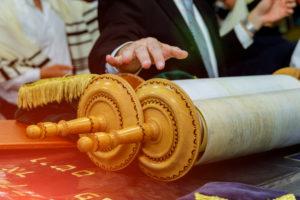
By Rabbi Shoshanah Tornberg
Parshat Terumah
In preparation for this Shabbat of Terumah, I have worked with a young student who celebrates his becoming a bar mitzvah this week. We have been exploring the meaning of the mishkan — that dwelling place for God that the Israelites created in the wilderness — the precursor to the Temple in Jerusalem. Terumah outlines the specific instructions for how the Israelites are to build this cultic centerpiece, right down to its measurements, materials and implements.
For contemporary Jews, it is hard to make much of the specificity of this blueprint/instruction manual. For the creative building type, the lushness and artfulness of the design compels. But how can it compel the rest of us? After all, Torah was not written for our ancestors alone: We were at Sinai, too. So there must be some meaning in the passages that describe the building of the Tabernacle for us, in this moment?
In these last two years, our sense of “space” has changed. The pandemic has kept us away from our mishkans. Our classrooms, chapels and buildings have not been where we gather. More and more we are continuing our communal activities and sharing our spiritual lives in the virtual world. We have switched from in-building learning and worship to livestreams and Zoom meetings.
And though many of us were hoping that our coming trajectory would move us back into our physical spaces — would let us come home — we likely will switch between the virtual and the physical to some extent and for some time to come. So, now we ask: If we cannot rely on our buildings as the places we gather in order to let God in, what do we do?
One answer to our current conundrum lies in our embracing a new understanding of space, though one that is, in reality, very old.
The Midrash collection, Bereishit Rabbah, teaches that God does not dwell in the universe; but rather the universe dwells within God (68). The midrash reminds us that God is often called “HaMakom” — the place. We hear in this reference an intimation of God as encompassing all other senses of place. God is not in space — God is outside of space, and space is in God.
Further, God is not in time — God is outside of time, and time is in God. So if God doesn’t dwell in the universe, or does so in a way that is not “of” the universe, then in creating the world, what does God do?
First, God created the world with laws we need — gravity, polarity, relativity, cause and effect, to name a few. God created the world in such a way as to make our existence possible. God designates and builds a space for us — for living things and the elements of our universe. God creates this world “like an apartment” [1] within existence — complete with the laws of physics, time and mind that render this a world in which we can thrive.
So, too, when we created a mishkan in ancient times, or when we create another kind of sacred place today, that space becomes designated in our world for God to be in our world — it is God’s apartment in our corporeal world. And just as the created universe follows laws that make our existence possible, so must our holy spaces follow patterns and intentions that can make God’s presence in our midst a reality.
Yes our buildings still exist and, yes, we still long to return to them in full force. One day, I pray we will. But in recognizing that, for now, they will not be the only or even primary place where we meet God and each other, now, here, in this moment. What do we need to do to make room for God without the building? What are the God-inviting laws and kavannot (intentions) that we can bring to our changing sense of space? What will God’s apartment look like now?
God is kadosh — holy; separate; source of, but not of, this realm. What are the ways that we can honor that separateness in our prayer, learning and celebration modes? Some of the ways we can sanctify online “spaces” — perhaps even in the emerging metaverse — have not yet been invented.
So we need to begin inventing them. If we participate in remote Jewish life, our tradition invites us to think carefully about how we carve out these spaces? Can we designate a sacred, separate space for our bodies when engaging in these gatherings? Can we control our surroundings so that they can be crafted for holiness? Can we give ourselves the gift of pause from all the other tasks that call to us?
Where is God?
Paraphrasing the Kotzker Rebbe, we answer — wherever we invite God in.
Rabbi Shoshanah Tornberg is the rabbi and educator at Old York Road Temple – Beth Am and a graduate of Hebrew Union College-Jewish Institute of Religion in New York and of its Rhea Hirsch School of Education in Los Angeles. The Board of Rabbis of Greater Philadelphia is proud to provide diverse perspectives on Torah commentary for the Jewish Exponent. The opinions expressed in this column are the author’s own and do not reflect the view of the Board of Rabbis.





